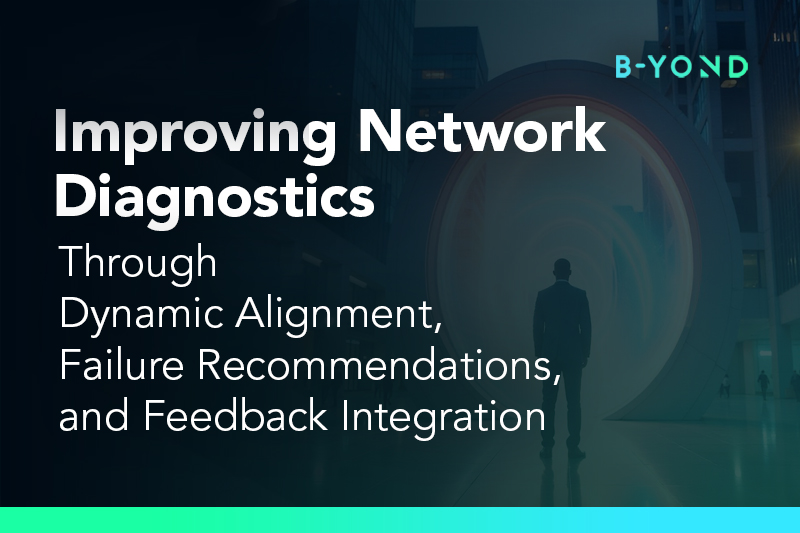Improving Network Diagnostics through Dynamic Alignment, Failure Recommendations, and Feedback Integration

Improving Network Diagnostics through Dynamic Alignment, Failure Recommendations, and Feedback Integration
Under the pressure of outages and network failures, network diagnostics remains one of the most manual and time-consuming challenges for operations organizations. Naturally, operators turn to AI and ML for solutions, but they often find that many AI-driven products claiming to identify the root cause of network issues fall short. These systems frequently rely on single-issue identification, failing to address the dynamic and varied nature of network environments and the multifaceted, complex underlying problems.
This is where AGILITY’s Adaptive Network Diagnostics steps in, powered by machine learning (ML) and designed to transcend these limitations. AGILITY's Recommendation engine accelerates diagnostics by analyzing vast volumes of past data patterns, adapting to changes in the network environment, and focusing on what matters most, without getting bogged down by irrelevant details.
1. The Challenge: Beyond a Single Point of Failure
Traditional diagnostic tools often struggle with pass-or-fail scenarios. They rely on single rule based or threshold-based systems that detect specific network events but fail to adapt to the complexity and variability of real-world conditions. As networks evolve, relying on these methods becomes increasingly insufficient.
B-Yond, through AGILITY, has analyzed millions of PCAPs (packet captures) from live networks and realized the need for a more advanced, scalable approach. Extending diagnostics with the Failure Recommendation not only accelerates the troubleshooting process but also enhances the precision of root cause analysis. This AI-driven feature evolves with the network and adapts to new patterns, making it more effective than traditional methods.
2. AGILITY Adaptive Network Diagnostics vs. Manual and Rule-Based Troubleshooting
- Manual Troubleshooting: Involves multiple engineers manually analyzing packet captures, often leading to long, costly war-room sessions and delayed issue resolution.
- Rule-Based Systems: Apply predefined rules to identify known issues but struggle with new or complex problems outside their scope, leading to missed patterns or false positives.
- AGILITY Adaptive Network Diagnostics: Automates diagnostics using a self-learning engine that compares new incidents to historical cases, providing precise recommendations and significantly reducing the time and effort spent on diagnostics.
3. What Is AGILITY Adaptive Network Diagnostics?
AGILITY’s Adaptive Network Diagnostics is an ML-powered feature designed to diagnose network issues by identifying patterns from historical cases. Similar to how streaming services suggest content based on your viewing history, Adaptive Network Diagnostics predicts potential network anomalies by comparing current issues with previously encountered ones.
AGLITY offers two (2) Modes of Operation:
- Rule Based Diagnostics:
- Leverages machine learning models to categorize network events based on predefined labels.
- Identifies potential issues with high accuracy.
- Adaptive Network Diagnostics:
- Uses sequence alignment algorithms (e.g., Levenshtein distance) to compare current incidents with historical data.
- Suggests likely root causes based on similarities.
4. How It Works
The Adaptive Network Diagnostics employs the Levenshtein distance-based sequence alignment algorithm to assess similarity between network events. By comparing current incidents with historical data, it accurately pinpoints potential causes, allowing engineers to focus on relevant information. This targeted approach minimizes distractions, helping teams avoid unnecessary exploration and make informed decisions rapidly.
5. Why Is AGILITY Adaptive Network Diagnostics Powerful?
The Adaptive Network Diagnostics is a transformative feature, offering several unique advantages over traditional diagnostics methods, including:
- Zooming in on Relevance: Instead of analyzing every data point, the Adaptive Network Diagnostics focuses only on the most relevant events, filtering out noise and irrelevant issues. This streamlining reduces the overwhelming complexity faced by engineers during triage.
- Analyzing PCAPs with Intelligence: Unlike manual methods, such as Wireshark, which require engineers to sift through raw packet data, the Adaptive Network Diagnostics identifies patterns that would typically go unnoticed, significantly speeding up the diagnostic process.
- Active Learning with User Feedback: Adaptive Network Diagnostics continuously improves by learning from user input, ensuring its predictions become more accurate over time. As engineers provide feedback, the model adapts, making each diagnostic session smarter than the last.
- On-Premises Knowledge Base: By adding new patterns to the knowledge base within the customer’s environment, AGILITY’s Adaptive Network Diagnostics allows for data privacy and security, ensuring sensitive information never leaves the premises.
- Handling Unseen Patterns: The Failure Recommendation is designed to adapt to new and unseen network patterns, offering predictions even for anomalies it has not encountered before.
- Resilience to Incomplete Captures: Even in cases where data is incomplete, missing, or noisy, the Adaptive Network Diagnostics is still capable of generating valuable insights, reducing dependency on perfect datasets.
6. How the Adaptive Network Diagnostics Collects and Integrates Feedback
A key aspect of the Adaptive Network Diagnostics is its feedback loop. After providing a prediction, the system allows users to confirm or adjust the recommendation. This feedback is then integrated into the algorithm, improving future accuracy. As the Adaptive Network Diagnostics continues to evolve, it becomes increasingly effective in diagnosing network issues and refining predictions based on real-world data.
The system also incorporates label management and automatic label creation, enhancing the user experience and ensuring that feedback is seamlessly integrated into the diagnostic process.
7. Achievements
The Adaptive Network Diagnostics has already proven to be a robust and scalable feature, accurately predicting network issues more than 90% of the time, while continuously learning and evolving with each case. This automation is significantly accelerating diagnostics, with Level 1 and Level 2 engineers benefiting greatly from its capabilities.
A Tier 1 customer in North America shared their experience:
"We must re-imagine how we analyze packet captures for escalation cases. Manual involvement is too expensive, slow, and inconsistent, and engineers often feel overwhelmed."
"During outage situations, reaching the root cause quickly is critical. Traditional methods, involving group triage sessions to analyze network captures, can last hours or even days."
For more details on how AGILITY Adaptive Network Diagnostics can transform your network diagnostics, Click to Book a Demo Here.


